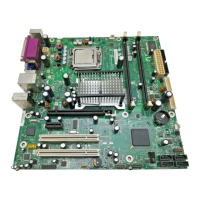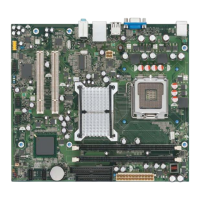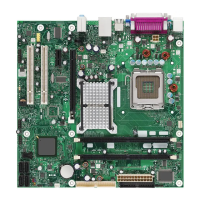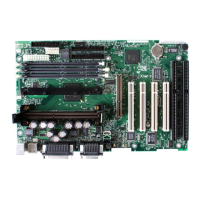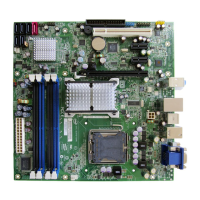Product Description
25
1.5.2 IDE Support
The board provides five IDE interface connectors:
• One parallel ATA IDE connector that supports two devices
• Four serial ATA IDE connectors that support one device per connector
1.5.2.1 Parallel ATE IDE Interface
The ICH7-R/ICH7-DH’s Parallel ATA IDE controller has one bus-mastering Parallel ATA
IDE interface. The Parallel ATA IDE interface supports the following modes:
• Programmed I/O (PIO): processor controls data transfer.
• 8237-style DMA: DMA offloads the processor, supporting transfer rates of up to
16 MB/sec.
• Ultra DMA: DMA protocol on IDE bus supporting host and target throttling and
transfer rates of up to 33 MB/sec.
• ATA-66: DMA protocol on IDE bus supporting host and target throttling and
transfer rates of up to 66 MB/sec. ATA-66 protocol is similar to Ultra DMA and is
device driver compatible.
• ATA-100: DMA protocol on IDE bus allows host and target throttling. The ICH7-R/
ICH7-DH’s ATA-100 logic can achieve read transfer rates up to 100 MB/sec and
write transfer rates up to 88 MB/sec.
NOTE
ATA-66 and ATA-100 are faster timings and require a specialized cable to reduce
reflections, noise, and inductive coupling.
The Parallel ATA IDE interface also supports ATAPI devices (such as CD-ROM drives)
and ATA devices using the transfer modes.
The BIOS supports Logical Block Addressing (LBA) and Extended Cylinder Head Sector
(ECHS) translation modes. The drive reports the transfer rate and translation mode to
the BIOS.
For information about Refer to
The location of the Parallel ATA IDE connector Figure 20, page 59
1.5.2.2 Serial ATA Interfaces
The ICH7-R/ICH7-DH’s Serial ATA controller offers four independent Serial ATA ports
with a theoretical maximum transfer rate of 3 Gbits/sec per port. One device can be
installed on each port for a maximum of four Serial ATA devices. A point-to-point
interface is used for host to device connections, unlike Parallel ATA IDE which supports
a master/slave configuration and two devices per channel.
For compatibility, the underlying Serial ATA functionality is transparent to the
operating system. The Serial ATA controller can operate in both legacy and native
modes. In legacy mode, standard IDE I/O and IRQ resources are assigned (IRQ 14
and 15). In Native mode, standard PCI Conventional bus resource steering is used.
